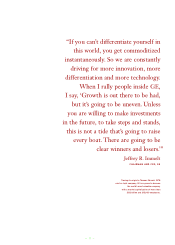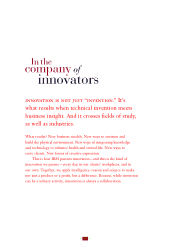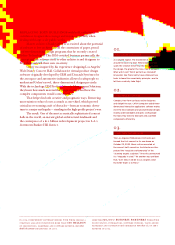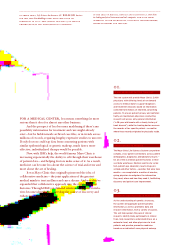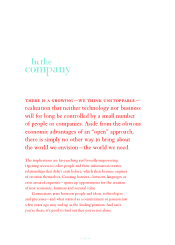IBM 2003 Annual Report Download - page 23
Download and view the complete annual report
Please find page 23 of the 2003 IBM annual report below. You can navigate through the pages in the report by either clicking on the pages listed below, or by using the keyword search tool below to find specific information within the annual report.
21
replacing boxy buildings with bold, reflective,
curvilinear designs takes courage and vision—especially when
dealing with large-scale public works.
Master architect Frank Gehry is so excited about the potential
of software to free architects from the constraints of paper, pencil
and two-dimensional design programs that he recently created
Gehry Technologies. This IBM-certified business partner sells the
concept and the software itself to other architects and designers to
help them unleash their own creativity.
Gehry was inspired by his experience designing Los Angeles’
Walt Disney Concert Hall. Collaborative virtual product design
software originally developed by IBM and Dassault Systèmes for
the aerospace and automotive industries allowed craftspeople to
understand Gehry’s novel, three-dimensional designs precisely.
With the technology, IBM Product Lifecycle Management Solutions,
they knew how much material the design required and how the
complex components would come together.
That helped in both creative and pragmatic ways. Removing
uncertainties reduced costs as much as one-third, which proved
critical in overcoming a raft of obstacles—from an economic down-
turn to a major earthquake—standing in the high-profile project’s way.
The result: One of the most acoustically sophisticated concert
halls in the world, an instant global architectural landmark and
the centerpiece of a $1.2 billion redevelopment project in L.A.’s
downtown Bunker Hill district.
01.
FIRST COMES CREATIVITY…
A crumpled napkin. The movement of water
around the bow of a boat. Who knows what will
spark the creative mind? But the more unusual
the design, the greater the risks. Can it be built?
What will it cost? Will it perform as intended?
Innovators like Frank Gehry have embraced new
tools to tame this uncertainty principle—and to
let their creativity take flight.
02.
…FOLLOWED BY SAVINGS…
Complex, free-form surfaces excite designers
and delight the eye. CATIA (computer-aided three-
dimensional interactive application) software makes
even the most complex and unconventional designs
readily understandable and gives craftspeople
the tools they need to fabricate and assemble
components efficiently.
03.
…AND THEN THE APPLAUSE
The Los Angeles Philharmonic Orchestra per-
formed the first concert in its new home on
October 23, 2003. Music critics marveled at
the concert hall’s acoustics. Architecture critics
praised the “exquisite craftsmanship” of the
“stunning organic sculpture.” One critic pronounced
it a “rhapsody in steel.” Yet another was confident
that, “over time, it will be to Los Angeles what
the Eiffel Tower is to Paris.”
in 2003, independent software vendors with whom ibm has a
strategic alliance influenced more than $10 billion
of ibm services, hardware and software revenue, more than
double the amount influenced in 2001.
more than 90,000 business partners worldwide
(consultants, integrators, software vendors, value-added
resellers and distributors) generated more than 1/3 of ibm’s
revenue in 2003.


